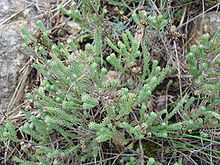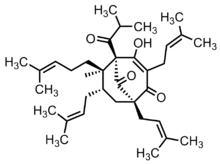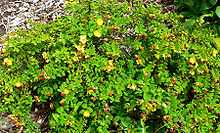Hypericum
| Hypericum | |
|---|---|
 | |
| Hypericum calycinum | |
| Scientific classification | |
| Kingdom: | Plantae |
| (unranked): | Angiosperms |
| (unranked): | Eudicots |
| (unranked): | Rosids |
| Order: | Malpighiales |
| Family: | Hypericaceae |
| Subfamily: | Hypericoideae |
| Tribe: | Hypericeae |
| Genus: | Hypericum L. |
| Species | |
|
490, see text | |
| Synonyms | |
|
Adenotrias Jaub. & Spach | |
Hypericum /ˌhaɪˈpɪərɨkəm/[1] is a genus of 490[2] species of flowering plants in the family Hypericaceae (formerly often considered a subfamily of Clusiaceae). Hypericum is unusual for a genus of its size because a worldwide taxonomic monograph[2] was produced for it by N.Robson (working at the Natural History Museum, London, UK, between 1977 and 2012). Robson recognizes 36 sections within Hypericum.
The genus has a nearly worldwide distribution, missing only from tropical lowlands, deserts and polar regions. All members of the genus may be referred to as St. John's wort, though they are also commonly just called hypericum, and some are known as tutsan. The marsh St. John's-worts are nowadays separated into the genus Triadenum.
Hypericums vary from herbaceous annual or perennials 5–10 cm tall to shrubs and small trees up to 12 m tall. The leaves are opposite, simple oval, 1–8 cm long, either deciduous or evergreen. The flowers vary from pale to dark yellow, and from 0.5–6 cm in diameter, with five (rarely four) petals, most having prominent stamens. The fruit is usually a dry capsule which splits to release the numerous small seeds; in some species it is fleshy and berry-like.
Uses of Hypericum

Some species are used as ornamental plants and have large, showy flowers. Numerous hybrids and cultivars have been developed for use in horticulture, such as H. × moserianum[3] (H. calycinum × H. patulum), H. 'Hidcote'[4] and H. 'Rowallane'.[5] All of the above cultivars have gained the Royal Horticultural Society's Award of Garden Merit.
St. John's-worts can occur as nuisance weeds in farmland and gardens. On pastures, some can be more than a nuisance, causing debilitating photosensitivity and sometimes abortion in livestock. The beetles Chrysolina quadrigemina, Chrysolina hyperici and the St. John's-wort Root Borer (Agrilus hyperici) like to feed on Common St. John's-wort (H. perforatum) and have been used for biocontrol where the plant has become an invasive weed.
Hypericum species are the only known food plants of the caterpillar of the Treble-bar, a species of moth. Other Lepidoptera species whose larvae sometimes feed on Hypericum include Common Emerald, The Engrailed (recorded on Imperforate St. John's-wort, H. maculatum), Grey Pug and Setaceous Hebrew Character.
Medical properties

Common St. John's-wort (H. perforatum) has long been used in herbalism. It was known to have medical properties in Classical Antiquity and was a standard component of theriacs, from the Mithridate of Aulus Cornelius Celsus' De Medicina (ca. 30 CE) to the Venice treacle of d'Amsterdammer Apotheek in 1686. Folk usages included oily extract ("St. John's oil") and Hypericum snaps.
H. perforatum is the most potent species and it is today grown commercially for use in herbalism and medicine; other St. John's-worts possess interesting properties and chemical compounds but are not well researched. As these secondary compounds appear to be related to deterring herbivores, they are present in varying and unpredictable quantities: still, a number of high-yield cultivars have been developed.
Two main compounds of interest have been studied in more detail: hyperforin and hypericin. However, the pharmacology of H. perforatum is not resolved, and at least its antidepressant properties are caused by a wide range of factors interacting. As psychiatric medication, it is usually taken as pills, or as tea. Standardised preparations are available, and research has mainly studied alcoholic extracts and isolated compounds. What research data exists supports a noticeable effect in many cases of light and medium depression,[6] but no significant improvement of severe depression and OCD.
The red, oily extract of H. perforatum may help heal wounds.[7][8] Both hypericin and hyperforin are reported to have antibiotic properties.[9] Justifying this view with the then-current doctrine of signatures, herbalist William Coles (1626–1662)[10] wrote in the 17th century that
"The little holes where of the leaves of Saint Johns wort are full, doe resemble all the pores of the skin and therefore it is profitable for all hurts and wounds that can happen thereunto."
Hypericum perforatum may also be capable of reducing the physical signs of opiate withdrawal.[11] Caution should be taken, as high-dosage H. perforatum interacts with a wide range of medications due to activation of the Pregnane X receptor detoxification pathway, and it also causes photosensitivity.
Hypericum extract, by inducing both the CYP3A4 and the P-glycoprotein (P-gp), can reduce the plasma concentrations of different antineoplastic agents such as imatinib, irinotecan and docetaxel, thus reducing the clinical efficacy of these drugs.[12]
Selected species






- Hypericum acmosepalum
- Hypericum acostanum
- Hypericum addingtonii
- Hypericum adenotrichum
- Hypericum aegypticum
- Hypericum anagalloides – creeping St. John's-wort, bog St. John's-wort, tinker's-penny
- Hypericum androsaemum – tutsan
- Hypericum annulatum
- Hypericum aphyllum
- Hypericum ascyron
- Hypericum asplundii
- Hypericum athoum
- Hypericum atomarium
- Hypericum augustinii
- Hypericum balearicum
- Hypericum balfourii
- Hypericum barbatum
- Hypericum beanii
- Hypericum bellum
- Hypericum boreale – northern St. John's-wort
- Hypericum buckleii – Blue Ridge St. John's-wort
- Hypericum bupleuroides
- Hypericum calycinum – great St. John's-wort, Jerusalem star, Rose of Sharon, Aaron's beard
- Hypericum canadense L. – Canadian St. John's-wort, Irish St. John's-wort
- Hypericum canariense – Canary Islands St. John's-wort
- Hypericum capitatum
- Hypericum cerastoides
- Hypericum choisianum
- Hypericum cistifolium
- Hypericum concinnum – goldwire
- Hypericum confertum
- Hypericum cordifolium
- Hypericum coris
- Hypericum crenulatum
- Hypericum crux-andreae
- Hypericum cumulicola – highlands scrub hypericum
- Hypericum curvisepalum
- Hypericum delphicum
- Hypericum densiflorum – glade St. John's-wort, dense St.John's-wort
- Hypericum denticulatum Walt. – coppery St. John's-wort
- Hypericum dissimulatum – disguised St. John's-wort
- Hypericum dyeri
- Hypericum eastwoodianum
- Hypericum elegans
- Hypericum ellipticum[13] – pale St. John's-wort
- Hypericum elodes – marsh hypericum
- Hypericum elongatum
- Hypericum empetrifolium
- Hypericum erectum
- Hypericum ericoides
- Hypericum fasciculatum
- Hypericum fieriense
- Hypericum foliosum
- Hypericum formosum – western St. John's-wort
- Hypericum forrestii – Forrest's tutsan
- Hypericum fragile
- Hypericum frondosum – cedarglade St. Johns-wort
- Hypericum galioides
- Hypericum gentianoides (L.) BSP. – orange-grass St. John's-wort, pinweed
- Hypericum glandulosum
- Hypericum gnidiifolium
- Hypericum gramineum
- Hypericum grandifolium – Canary Island St. John's-wort
- Hypericum graveolens
- Hypericum hartwegii
- Hypericum henryi
- Hypericum hircinum L. – stinking tutsan
- Hypericum hirsutum L. – hairy St. John's-wort
- Hypericum hookerianum
- Hypericum humifusum L. – trailing St. John's-wort
- Hypericum hypericoides
- Hypericum hyssopifolium
- Hypericum × inodorum
- Hypericum japonicum
- Hypericum kalmianum – Kalm's St. John's-wort
- Hypericum kamtschaticum Ledeb.
- Hypericum kelleri
- Hypericum kotschyanum
- Hypericum kouytchense
- Hypericum lagarocladum
- Hypericum lancasteri – Lancaster's St. John's-wort
- Hypericum lanceolatum
- Hypericum lanuginosum
- Hypericum leschenaultii
- Hypericum linariifolium – toadflax-leaved St. John's-wort
- Hypericum linarioides
- Hypericum llanganaticum
- Hypericum lobbii
- Hypericum lobocarpum
- Hypericum maclarenii
- Hypericum maculatum – imperforate St. John's-wort
- Hypericum maguirei
- Hypericum majus – larger Canadian St. John's-wort
- Hypericum matangense
- Hypericum monogynum
- Hypericum montanum L. – pale St. John's-wort
- Hypericum montbretii
- Hypericum × moserianum
- Hypericum mutilum L. – dwarf St. John's-wort
- Hypericum myricariifolium Hieron.
- Hypericum mysorense B.Heyne
- Hypericum nanum
- Hypericum nudiflorum
- Hypericum nummularium – round-leaved St. John's-wort
- Hypericum oblongifolium
- Hypericum olympicum
- Hypericum orientale
- Hypericum origanifolium
- Hypericum pallens
- Hypericum patulum Thunb
- Hypericum peninsulare
- Hypericum perfoliatum
- Hypericum perforatum – common St. John's-wort, perforate St John's-wort, Tipton's weed, Klamath weed
- Hypericum prietoi
- Hypericum prolificum – shrubby St. John's-wort
- Hypericum pseudohenryi – Irish tutsan
- Hypericum pulchrum – slender St. John's-wort
- Hypericum punctatum Lam. – spotted St. John's-wort
- Hypericum quitense
- Hypericum reflexum
- Hypericum reptans
- Hypericum reductum
- Hypericum revolutum Vahl
- Hypericum richeri
- Hypericum roeperanum Schimp. ex A. Rich.
- Hypericum rumeliacum
- Hypericum sampsonii
- Hypericum scopulorum
- Hypericum scouleri – western St. John's-wort
- Hypericum setosum
- Hypericum socotranum
- Hypericum sphaerocarpum – roundfruit St. John's-wort
- Hypericum spruneri
- Hypericum stellatum
- Hypericum subsessile
- Hypericum tenuicaule
- Hypericum tetrapterum – square-stalked St. John's-wort, square-stemmed St. John's-wort, St. Peter's-wort, Peterwort
- Hypericum tomentosum
- Hypericum tortuosum
- Hypericum trichocaulon
- Hypericum triquetrifolium Turra – curled-leaved St. John's-wort
- Hypericum undulatum – wavy St. John's-wort
- Hypericum uralum
- Hypericum vacciniifolium
- Hypericum wilsonii
- Hypericum xylosteifolium – Turkish tutsan
- Hypericum yakusimense
Cultivars
Cultivars include:
- Hypericum calycinum 'Hidcote'
- Hypericum perforatum 'Anthos'
See also
- Adverse effects of drugs
References
- ↑ Sunset Western Garden Book, 1995:606–607
- ↑ 2.0 2.1 http://hypericum.myspecies.info/ Hypericum Online
- ↑ "RHS Plant Selector". Royal Horticultural Society. Retrieved 19 May 2013.
- ↑ "RHS Plant Selector". Royal Horticultural Society. Retrieved 19 May 2013.
- ↑ "RHS Plant Selector". Royal Horticultural Society. Retrieved 19 May 2013.
- ↑ Szegedi, A; Kohnen, R; Dienel, A; Kieser, M (2005). "Acute treatment of moderate to severe depression with hypericum extract WS 5570 (St John's wort): Randomised controlled double blind non-inferiority trial versus paroxetine". BMJ 330 (7490): 503. doi:10.1136/bmj.38356.655266.82. PMC 552808. PMID 15708844.
- ↑ Samadi, S; Khadivzadeh, T; Emami, A; Moosavi, NS; Tafaghodi, M; Behnam, HR (2010). "The effect of Hypericum perforatum on the wound healing and scar of cesarean". Journal of alternative and complementary medicine 16 (1): 113–7. doi:10.1089/acm.2009.0317. PMID 20064022.
- ↑ Süntar, Ipek Peşin; Akkol, Esra Küpeli; Yılmazer, Demet; Baykal, Turhan; Kırmızıbekmez, Hasan; Alper, Murat; Yeşilada, Erdem (2010). "Investigations on the in vivo wound healing potential of Hypericum perforatum L". Journal of Ethnopharmacology 127 (2): 468–77. doi:10.1016/j.jep.2009.10.011. PMID 19833187.
- ↑ Schempp, Christoph M; Pelz, Klaus; Wittmer, Annette; Schöpf, Erwin; Simon, Jan C (1999). "Antibacterial activity of hyperforin from St John's wort, against multiresistant Staphylococcus aureus and gram-positive bacteria". The Lancet 353 (9170): 2129. doi:10.1016/S0140-6736(99)00214-7. PMID 10382704.
- ↑ Coles, William (1657). Adam in Eden, or, Natures paradise. OCLC 217197164.
- ↑ Subhan, F; Khan, N; Sewell, RD (2009). "Adulterant profile of illicit street heroin and reduction of its precipitated physical dependence withdrawal syndrome by extracts of St John's wort (Hypericum perforatum)". Phytotherapy research 23 (4): 564–71. doi:10.1002/ptr.2692. PMID 19067385.
- ↑ Caraci, F; Crupi, R; Drago, F; Spina, E (2011). "Metabolic drug interactions between antidepressants and anticancer drugs: Focus on selective serotonin reuptake inhibitors and hypericum extract". Current drug metabolism 12 (6): 570–7. PMID 21395523.
- ↑ Hypericum ellipticum. USDA PLANTS Profile.
External links
| Wikimedia Commons has media related to Hypericum. |
University of Illinois Extension. "Selecting Shrubs for Your Home - Kalm St. Johnswort (Hypericum kalmianum)".




